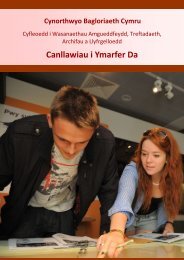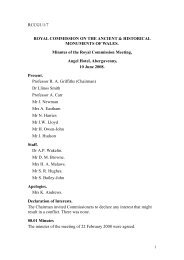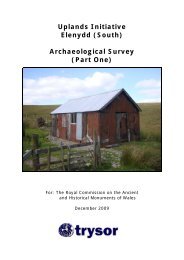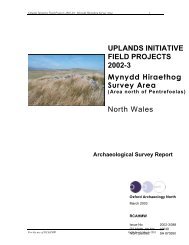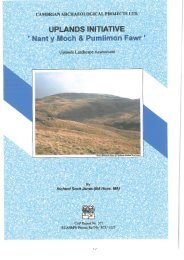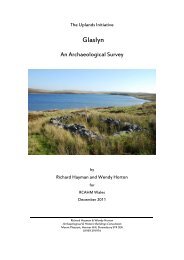Banc y Celyn, Brecknockshire - Royal Commission on the Ancient ...
Banc y Celyn, Brecknockshire - Royal Commission on the Ancient ...
Banc y Celyn, Brecknockshire - Royal Commission on the Ancient ...
- No tags were found...
Create successful ePaper yourself
Turn your PDF publications into a flip-book with our unique Google optimized e-Paper software.
Uplands Initiative – <str<strong>on</strong>g>Banc</str<strong>on</strong>g> y <str<strong>on</strong>g>Celyn</str<strong>on</strong>g> 20083.1 <str<strong>on</strong>g>Banc</str<strong>on</strong>g> y <str<strong>on</strong>g>Celyn</str<strong>on</strong>g> History and Archaeology3.1.1 Characteristics and comparis<strong>on</strong>sLike many upland areas, <strong>the</strong> history of <strong>the</strong> <str<strong>on</strong>g>Banc</str<strong>on</strong>g> y <str<strong>on</strong>g>Celyn</str<strong>on</strong>g> area is not well documentedand we are dependent <strong>on</strong> a small number of sources to attempt to c<strong>on</strong>struct anunderstanding of <strong>the</strong> past use of <strong>the</strong> land included in <strong>the</strong> study area.An obvious and important characteristic of <str<strong>on</strong>g>Banc</str<strong>on</strong>g> y <str<strong>on</strong>g>Celyn</str<strong>on</strong>g> is that it has remained an areaof unenclosed comm<strong>on</strong> land to <strong>the</strong> present day. Despite attempts at enclosure and landimprovement around <strong>the</strong> comm<strong>on</strong> fringe, <strong>the</strong> footprint of modern agriculture remainsrelatively light here, and as a result <strong>the</strong> survival of archaeological features is reas<strong>on</strong>ably good.We are wholly dependent <strong>on</strong> archaeology to interpret <strong>the</strong> level and nature of humanactivity <strong>on</strong> <strong>the</strong>se hills before <strong>the</strong> Medieval period. The archaeological record begins in<strong>the</strong> Neolithic period, for <strong>the</strong> Bailey Bach chambered tomb (NPRN 275624) is a rareexample of a Neolithic funerary m<strong>on</strong>ument in <strong>the</strong> mid-Wales uplands. It is not <strong>the</strong> <strong>on</strong>lysite of relevance to <strong>the</strong> Neolithic in <strong>the</strong> area however. The RCAHMW’s BrecknockInventory (RCAHMW, 1997, 290) records that <strong>the</strong> flint scrapers, a triangular arrowheadand worked and unworked flakes, all of Neolithic date, have been found near WaunGynllwch (SO063415). A Neolithic st<strong>on</strong>e hammer head has also been found atCrickadarn, just to <strong>the</strong> east of <strong>the</strong> study area (RCAHMW, 1997, 290).There is c<strong>on</strong>siderably more evidence of Br<strong>on</strong>ze Age activity in <strong>the</strong> study area, in <strong>the</strong>form of over 20 funerary cairns and barrows. The best preserved of <strong>the</strong>se is a finebarrow, possibly a ring cairn, <strong>on</strong> Cefn Clawdd (NPRN 305784), and <strong>the</strong> mainc<strong>on</strong>centrati<strong>on</strong> of <strong>the</strong>se m<strong>on</strong>uments occurs al<strong>on</strong>g or adjacent to <strong>the</strong> western end of <strong>the</strong>Cefn Clawdd ridge. This includes a group of features at Twyn y Post which have beenrecorded as a Prehistoric M<strong>on</strong>ument Complex (NPRN 307215). The group is shown <strong>on</strong><strong>the</strong> 1831 Ordnance Survey map as c<strong>on</strong>sisting of three cairns or barrows. Today, <strong>on</strong>est<strong>on</strong>e cairn (NPRN 247188) can be seen at Twyn y Post, al<strong>on</strong>gside what may be <strong>the</strong>very disturbed remains of a sec<strong>on</strong>d cairn (NPRN 247189), and an unusual earthworkwhich may well be a ring barrow (NPRN 247190). No settlement sites of <strong>the</strong> period areknown locally. Some finds of Br<strong>on</strong>ze Age artefacts from <strong>the</strong> surrounding area indicatefur<strong>the</strong>r activity, including a st<strong>on</strong>e axe from Erwood (RCAHMW, 1997, 294) and asocketed br<strong>on</strong>ze axe from Crickadarn (RCAHMW, 1997, 296). To <strong>the</strong> west of <strong>the</strong> studyarea, at Cornelau Uchaf, Upper Chapel, a sherd of possible Deverel-Rimbury ware,apparently from a “globular urn”, has also been reported (RCAHMW, 1997, 72).It is worth noting that <strong>the</strong>re are no round barrows in this study area, unlike those foundless that 5km to <strong>the</strong> nor<strong>the</strong>ast <strong>on</strong> Aberedw Hill, which was surveyed during 2007-2008(Hall & Sambrook, 2008a). The cairns of <str<strong>on</strong>g>Banc</str<strong>on</strong>g> y <str<strong>on</strong>g>Celyn</str<strong>on</strong>g> are mostly low, denudedmounds composed of small st<strong>on</strong>es, with piles of larger blocks (which are ei<strong>the</strong>r latermarker cairns or part of <strong>the</strong> original cairn structure) placed <strong>on</strong> <strong>the</strong> cairn body. They varyin size from as little as 4m in diameter (Gwaun Ymrys<strong>on</strong> Cairn IV, NPRN 247251) to18m (Cefn Clawdd II, NPRN 305784).Interestingly, in <strong>the</strong> nor<strong>the</strong>rn part of <strong>the</strong> area <strong>the</strong>re is a notable absence of cairns orbarrows, which mirrors <strong>the</strong> findings of <strong>the</strong> upland survey carried out <strong>on</strong> <strong>the</strong> SENTA rangeby Trysor in 2008 (Hall & Sambrook, 2008b). The sole prehistoric site recorded <strong>on</strong> <strong>the</strong>25


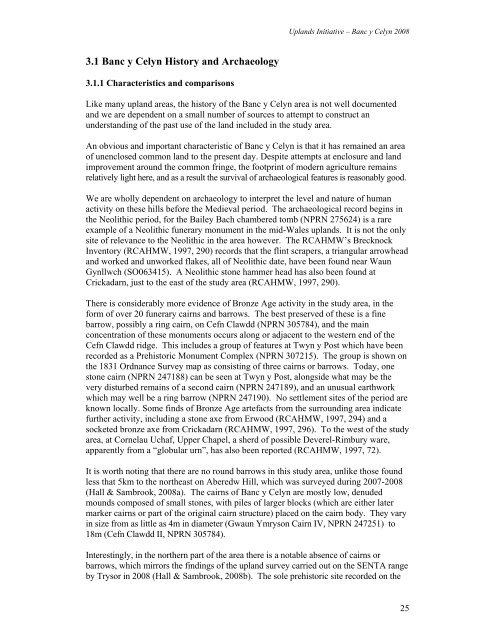

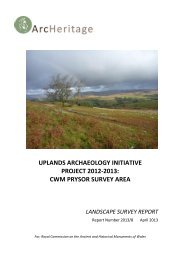
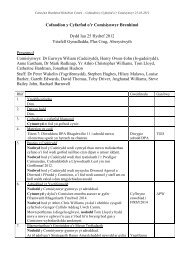
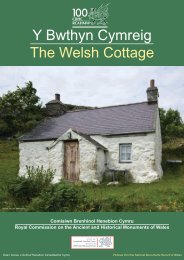
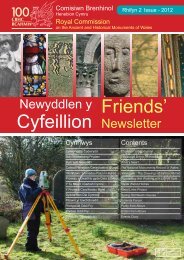
![The Source of the Usk Walk [2012 PDF]](https://img.yumpu.com/49285699/1/190x245/the-source-of-the-usk-walk-2012-pdf.jpg?quality=85)

